Polar
From ViRBO
Contents |
1. Summary
![From [1]](/wiki/images/thumb/polar.png/193px-polar.png)
POLAR is one of four spacecraft in the Global Geospace Science (GGS) program. These are among the six spacecraft in the International Solar Terrestrial Physics (ISTP) program. POLAR provides multi-wavelength imaging of the aurora, measuring plasma entry into the polar magnetosphere and geomagnetic tail, the flow of plasmas to and from the ionosphere, and the deposition of particle energy in the ionosphere and upper atmosphere. POLAR has on-board propulsion systems and a design lifetime of three to five years, with redundant subsystems. POLAR is cylindrical, approximately 2.8 m in diameter by 1.25 m high (plus 1.25 m for its two despun platforms), with body-mounted solar cells, weighs 1250 kg and uses 333 W of power. The spin rate is 10 rpm around an axis approximately normal to the orbital plane. It has long wire spin-plane antennas, inertial booms, and spin-plane appendages to support sensors. POLAR has two despun gimbaled instrument platforms, and booms are deployed along both Z axes. Data are stored using on-board tape recorders and are relayed to the Deep Space Network at 600 kbps maximum (250 kbps nominal) although the average real-time data rate for POLAR is 41.6 kbps. POLAR has a 22.6-h polar orbit (90 deg inclination), with perigee and apogee of 11,500 and 57,000 km. Polar was launched to observe the polar magnetosphere and, as its orbit has precessed with time, has observed the equatorial inner magnetosphere and is now carrying out an extended period of southern hemisphere coverage. Details on the POLAR mission and instrumentation are provided in Space Science Reviews (Vol. 71, Nos. 1-4, 1995) and reprinted in The Global Geospace Mission, edited by C. T. Russell (Kluwer, 1995).
2. SPASE
- Satellite
- RB-related instruments: CAMMICE | CEPPAD | Hydra | TIMAS
- Data products: CEPPAD data at ViRBO | CAMMICE/MICS data at BU
3. Research
- Search ADS abstracts for keyword Polar+radiation+belt
- NASA Polar mission web page
4. Data: CAMMICE/MICS
The Magnetospheric Ion Composition Sensor (MICS) on Polar's Charge and Mass Magnetospheric Ion Composition Experiment (CAMMICE)
- More information: bu.edu | lanl.gov | Search ADS abstracts for keyword Polar+CAMMICE+Instrument
- Data: at CDAWeb.
- Plots: These data may be browsed by:
- launching Autoplot with ViRBO's bookmarks and selecting a parameter in the bookmarks menu under
Heliophysics/CDAWeb/Raw/Polar/CAM.
- launching Autoplot with ViRBO's bookmarks and selecting a parameter in the bookmarks menu under
- Plots: These data may be browsed by:
- Data: at Boston University.
- Plots: These data may be browsed in Autoplot by any of the following methods:
- Clicking the image on the left below to show pre-generated plots in your web browser over the full time range of available data (showing data from select parameters).
- Clicking the image on the right below to bring up one day of data in Autoplot (showing data from select parameters).
- launching Autoplot with ViRBO's bookmarks and selecting a parameter in the bookmarks menu under
Heliophysics/ViRBO/Special Views/Polar/CAMorHeliophysics/ViRBO/Raw/Polar/CAM.
- Plots: These data may be browsed in Autoplot by any of the following methods:
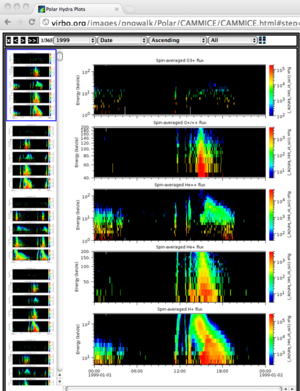 View a pre-generated image gallery in your web browser.
View a pre-generated image gallery in your web browser.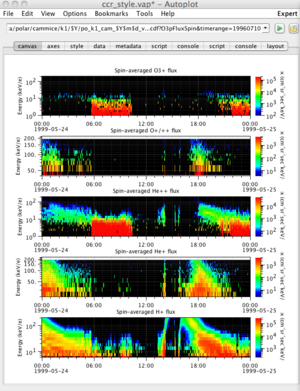 Browse this special data view using the Autoplot application.
Browse this special data view using the Autoplot application.
5. Data: CEPPAD
Comprehensive Energetic Particle Pitch Angle Distribution
- Information: Search ADS abstracts for keyword Polar+CEPPAD+Instrument
- Data: 96-second averaged data at CDAWeb.
- Plots: These data may be browsed in Autoplot by launching Autoplot with ViRBO's bookmarks and selecting a parameter in the bookmarks menu under
Heliophysics/CDAWeb/Raw/Polar/CEP.
- Plots: These data may be browsed in Autoplot by launching Autoplot with ViRBO's bookmarks and selecting a parameter in the bookmarks menu under
- Data: ~24-second cadence data at ViRBO (provided by Reiner Friedel; files follow the PRBEM standard).
- Plots: These data may be browsed in Autoplot by launching Autoplot with ViRBO's bookmarks and selecting a parameter in the bookmarks menu under
Heliophysics/ViRBO/Raw/Polar/CEP.
- Plots: These data may be browsed in Autoplot by launching Autoplot with ViRBO's bookmarks and selecting a parameter in the bookmarks menu under
6. Data: Hydra
A set of electrostatic analyzers that measure electron and ion velocity distributions.
- More information: uiowa.edu | Search ADS abstracts for keyword Polar+Hydra+Instrument
- Data: at CDAWeb.
- Plots: These data may be browsed in Autoplot by using any of the following methods:
- launching Autoplot with ViRBO's bookmarks and selecting any of the parameters in the bookmarks menu under
Heliophysics/ViRBO/Special Views/Polar/HYDorHeliophysics/CDAWeb/Raw/Polar - Clicking the left image below to show pre-generated plots in your web browser over the full time range of available data (showing data from two select parameters).
- Clicking the right image below to bring up one day of data in Autoplot (showing data from two select parameters).
- launching Autoplot with ViRBO's bookmarks and selecting any of the parameters in the bookmarks menu under
- Plots: These data may be browsed in Autoplot by using any of the following methods:
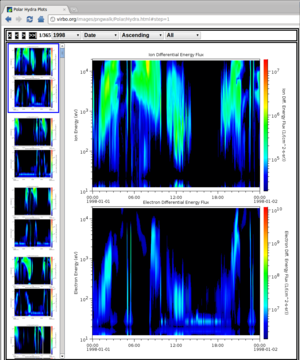 View a pre-generated image gallery in your web browser.
View a pre-generated image gallery in your web browser.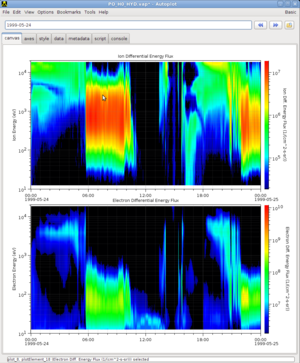 Browse a special data view using Autoplot.
Browse a special data view using Autoplot.
7. Data: TIMAS
The Toroidal Imaging Mass-Angle Spectrograph (TIMAS)
- More information: lasp.colorado.edu | Search ADS abstracts for keyword Polar+TIMAS+Instrument
- Data: at CDAWeb.
- Plots: These data may be browsed in Autoplot by
- Launching Autoplot with ViRBO's bookmarks and selecting a parameter in the bookmarks menu under
Heliophysics/CDAWeb/Raw/Polar/TIMorHeliophysics/CDAWeb/Raw/Polar/tim(note - not all parameters can be plotted at this time). - Clicking the image on the left below to show pre-generated plots in your web browser over the full time range of available data (showing data from select parameters).
- Clicking the right image below to bring up one day of data in Autoplot (showing data from select parameters).
- Launching Autoplot with ViRBO's bookmarks and selecting a parameter in the bookmarks menu under
- Plots: These data may be browsed in Autoplot by
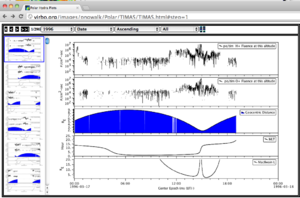 View a pre-generated image gallery in your web browser.
View a pre-generated image gallery in your web browser.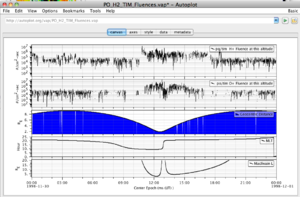 Browse this special data view using the Autoplot application.
Browse this special data view using the Autoplot application.
